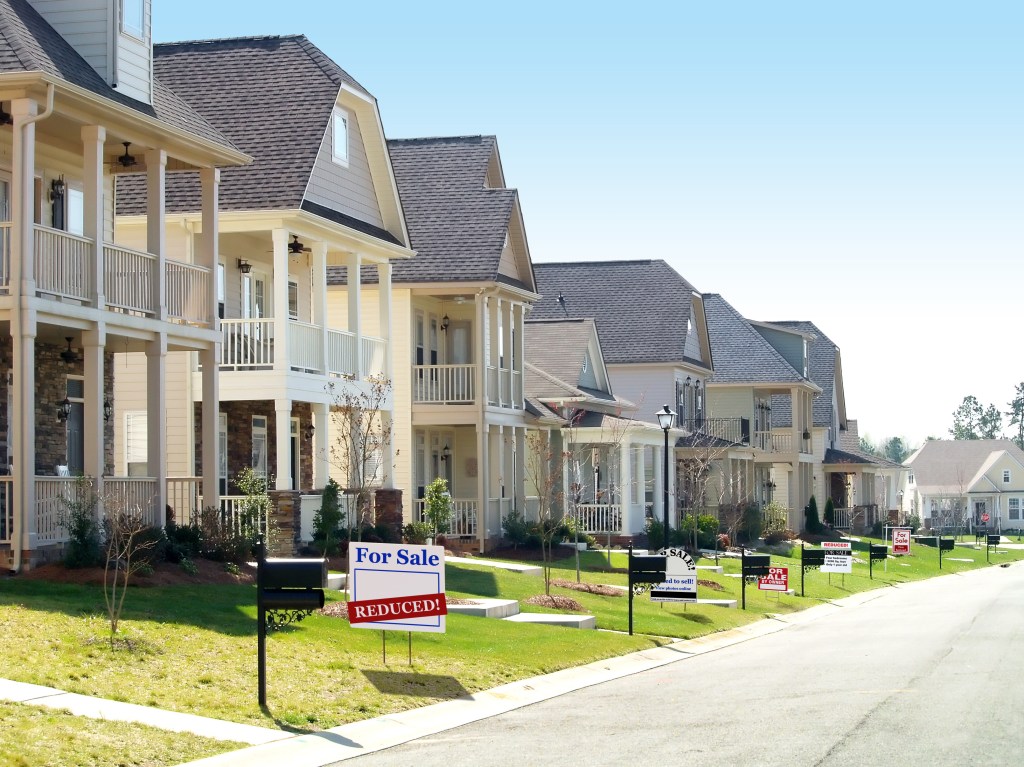
It wasn’t so long ago that the housing market was characterized by YOLO, FOMO and 200-person deep lines at open houses. But a gradual slowdown that culminated in seismic shocks to the economy over the past week has changed the game for real estate agents and their clients.
By the close of business on Monday, the stock market officially entered bear territory, with the Dow Jones falling 876 points on the fears of inflation and the Fed’s upcoming rate hike, rumored to be 75 basis points. Mortgage rates shot up to 6% on Monday, the highest level in more than a decade. And it will almost certainly continue to rise. Buyers and sellers are getting scared, and deals are at risk of collapsing.
“Interest rates are obviously rising and they are probably going to go up quite a bit again this week, so I’ve got buyers that are under contract now, but not closed and they are all texting me going, ‘Oh no, look at this,’” said Anne-Marie Wurzel, who leads a top real estate team for Mainframe Real Estate in Orlando, Florida. “But I tell them that this is why the lender and I wanted them to lock in on a rate and close a couple of days early so they could keep their rate. So buyers are getting concerned. For sellers, if they have the right agent educating and informing them of how to correctly price a home then they should not be too worried. But if the highest priced comp in your neighborhood is $775,000 and you want to list for over $800,000, you can’t. Interest rates are going up and there is no more price upswing to catch.”
“People are more hesitant,” added Austin, Texas-based Bramlett Residential Real Estate agent Jeremy Vandermause. “They lost buying power. I have a client right now whose price range was $400,000 to $420,000 and now it is more in the $360,000 to $390,000 range because her original budget was when interest rates were at 3% or 4%.”
In recent weeks, rates ticked up, housing inventory returned, and fears of a recession permeated, sending real estate agents scrambling as their buyers dropped out, or by contrast, suddenly found themselves the only bidders on a home that a month ago would have attracted a half-dozen bids. And that was before the emergence of some of most volatile market conditions in decades. In the short term, it’s dicey out there. But it might also bring about normalized conditions in the long run, agents said.
Hello inventory, my old friend
Active listings were up 13% year over year for the week that ended on June 4, according to a report by Realtor.com. The number of new listings was up 2% compared to a year ago.
The rise in inventory and drop in buyer demand is a welcome development for Fort Collins, Colorado-based Coldwell Banker agent Sarah Goodyear. In early May, she helped a client put an offer in on a home and it turned out to be the only offer on the property.
“That hasn’t happened in a long time, so it was pretty different,” Goodyear said. “Last spring was completely insane. We were having like 20 to 30 offers every time we had a listing on the market and the offers would come in from day one until the seller said enough is enough. Usually, it would be like three or four days and there would be an accepted offer.”
In Phoenix, arguably the hottest housing market in America over the last two years, inventory has increased dramatically. As of June 12, the number of active listings in the metro area jumped to 11,040, pending sales were at 10,164 and the inventory absorption rate was 37.1 days, Dean Carver at United Brokers Group wrote on Twitter. On March 25, 2022, the number of active listings was 4,911, pending sales were 12,310, and the inventory absorption rate was 17.29 days.
“Inventory is rising and days on market is also a bit longer, but we still have a significant turnover of existing product,” Bob Nathan, a local Engels & Völkers agent, said. “It is not a crazy hot market anymore, it is now just a very strong market, but there are less concessions being given up by the buyer. So, it is a little bit more back towards normal.”
In Raleigh, North Carolina, another housing market that’s been scorching since the beginning of the pandemic, 673 homes were sold in April, a 14.2% decline year over year, according to Redfin.
“It is still a very strong sellers’ market and there is not enough inventory for the buyers, however, I have seen a shift in the number of offers that we are receiving,” local Marti Hampton Real Estate agent Marti Hampton said. “A few months ago, we were receiving 30 or 40 offers on a single property and that has dropped down some. We have seen a slight seasonal increase inventory like we normally would see this time of year, but it is still now enough.”
Despite fewer buyers, homes are still moving briskly, with a median of just 19 days on the market, down 15 days from a year prior.
Drop that price
Austin, Texas, whose housing market generated plenty of headlines over the past 18 months, is also seeing a bit of a slowdown. According to Redfin, the number of homes sold in Austin in April was 1,232, down 13.9% year over year. However, the median sales price of $656,000 was still up 12.7%.
“In the past couple of weeks, it has certainly slowed down quite a bit,” Vandermause said. “Instead of seeing 10 plus offers on something you are seeing more like five offers. Instead of going in three of four days homes are now sitting a bit longer, usually around a week, but in some cases a home will sit for a month. If nobody is bidding at the original list price within the first couple of weeks, we are seeing price drops.”
In Provo, Utah, which is just south of Salt Lake City, Redfin reported that the number of homes sold in April was down 27.4% year over year to 82 homes, but the median number of days a home spent on the market dropped by one day from a year prior to eight days.
“It is not as white-hot as it was last year,” Becca Summers, a local Keller Williams agent, said. “Inventory levels have also gone up. It feels more like a 2019 environment. Demand is still there, but a lot of the buyers are buying because of personal reasons not because they want to get into the equity growth environment. If you list the home at the right price, you may still get multiple offers but it is more like three offers instead of 30.”
In addition, Summers said that roughly 50% of the housing inventory right now has been on the market for longer than the average time on market and that roughly 25% of the housing market has undergone a price drop in the last 14 days.
Less traditionally hot markets, like Huntsville, Alabama, which has become a hotspot for iBuyers and investors, are also seeing a slowdown. “Market went from very crazy/irrational to just hot and balancing very quickly,” Bert Klimer, a local agent with Legend Realty wrote in a tweet. “Investor demand drying up with 6% interest rates. Sellers starting to panic they missed the top.”
Also feeling this market shift are the ever popular homebuying destinations of Orlando, New York City and San Diego.
Redfin reported that the number of homes sold in Orlando in April was down 17.3% year over year to 1,130 homes but like in other markets, the median number of days a home spends on the market remains low, at just eight days.
“I feel like we might be at the tail end of the current market, but there is still time to for sellers to capitalize if they are realistic,” Wurzel of Mainframe Real Estate said. “I am seeing some price reductions and that is something I haven’t seen in about two-and-a-half years.”
Like Orlando, New York City is seeing a dip in the number of homes sold. In April, Redfin reported that the number of homes sold in the city was down 7.6% compared to a year ago to 3,142 homes.
“In the Manhattan market we are still seeing some increases in the amount of inventory coming to the market, but there is still a strong pace of demand, so we have yet to see an overhang of inventory,” local Sotheby’s International Realty agent Stan Ponte said. “Buyers and sellers are choosing to act now rather than wait to see what happens.”
Offers on the table
In San Diego, local Compass agent Todd Armstrong said that instead of seeing 20 or 30 offers per property he is seeing five or six.
“We are starting to see more inventory and a slowdown in the number of showings and the number of clients, as well as some price reductions on properties that have sat on the market for more than a week, which for a while has been unheard of, but this is more how the market should be.”
Agents that RealTrends spoke to echoed Armstrong’s view that the current shift in the housing market is not something buyers or sellers should be too concerned about.
“I have been in business for 30 years,” Hampton said. “During the Great Recession, it was like somebody turned the faucet off. It was gangbusters, home sales like crazy, then all of a sudden it went down. I don’t thing we are going to have the same kind of issue now because the same cards aren’t at play, but I do think that especially at the high-end things might be slowing at some point in the future.”
For Summers in Provo, pricing – as always – is key to success: “To succeed in this market, you have to know how to price a house correctly. If you strategize properly, you can still get great results.”
So, while the trends currently seen in many of these major markets are showing signs of a downturn, there is a long way to go before we dip into a housing market like that of 2008.
“We always want to compare today’s market to previous markets to look for tea leaves and I think that post most of COVID, it is very hard to see the tea leaves in the same way because we have so many different factors,” she said. “I think trying to predict how all of these factors will come together is very challenging, but I feel like this is a return to more normal market conditions.”


